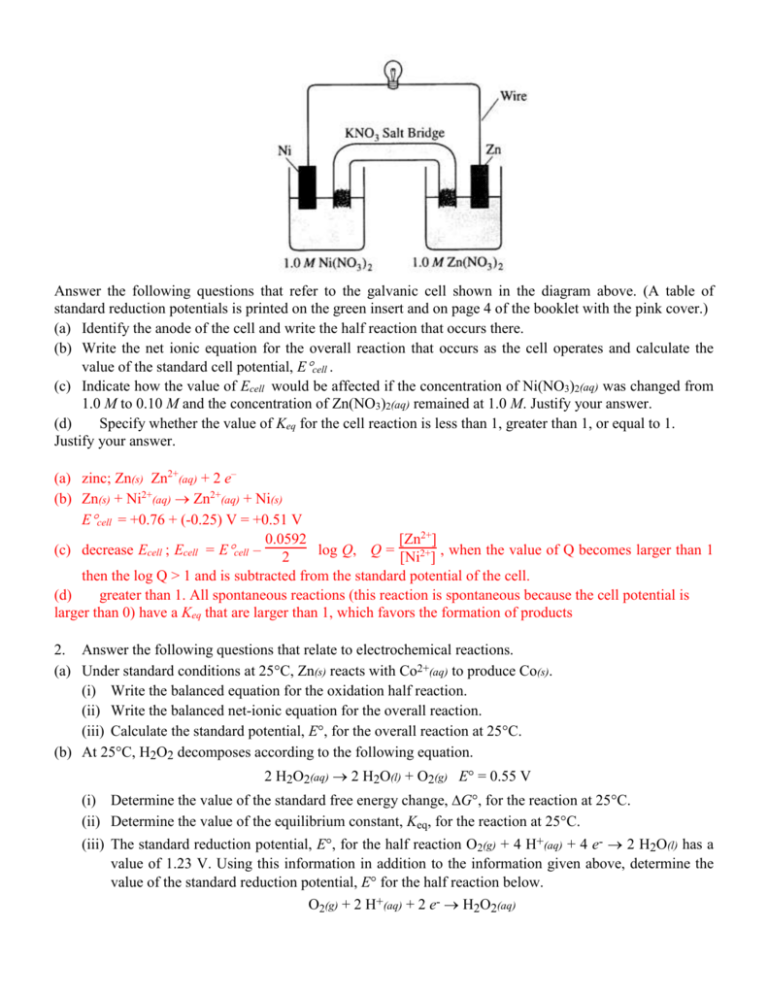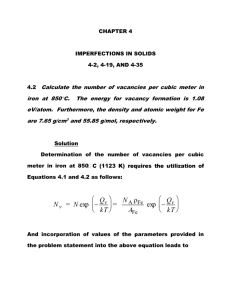Answers to Electrochem AP Questions
advertisement

Answer the following questions that refer to the galvanic cell shown in the diagram above. (A table of standard reduction potentials is printed on the green insert and on page 4 of the booklet with the pink cover.) (a) Identify the anode of the cell and write the half reaction that occurs there. (b) Write the net ionic equation for the overall reaction that occurs as the cell operates and calculate the value of the standard cell potential, Ecell . (c) Indicate how the value of Ecell would be affected if the concentration of Ni(NO3)2(aq) was changed from 1.0 M to 0.10 M and the concentration of Zn(NO3)2(aq) remained at 1.0 M. Justify your answer. (d) Specify whether the value of Keq for the cell reaction is less than 1, greater than 1, or equal to 1. Justify your answer. (a) zinc; Zn(s) Zn2+(aq) + 2 e– (b) Zn(s) + Ni2+(aq) Zn2+(aq) + Ni(s) Ecell = +0.76 + (-0.25) V = +0.51 V 0.0592 [Zn2+] (c) decrease Ecell ; Ecell = Ecell – 2 log Q, Q = [Ni2+] , when the value of Q becomes larger than 1 then the log Q > 1 and is subtracted from the standard potential of the cell. (d) greater than 1. All spontaneous reactions (this reaction is spontaneous because the cell potential is larger than 0) have a Keq that are larger than 1, which favors the formation of products 2. Answer the following questions that relate to electrochemical reactions. (a) Under standard conditions at 25C, Zn(s) reacts with Co2+(aq) to produce Co(s). (i) Write the balanced equation for the oxidation half reaction. (ii) Write the balanced net-ionic equation for the overall reaction. (iii) Calculate the standard potential, E, for the overall reaction at 25C. (b) At 25C, H2O2 decomposes according to the following equation. 2 H2O2(aq) 2 H2O(l) + O2(g) E = 0.55 V (i) Determine the value of the standard free energy change, G, for the reaction at 25C. (ii) Determine the value of the equilibrium constant, Keq, for the reaction at 25C. (iii) The standard reduction potential, E, for the half reaction O2(g) + 4 H+(aq) + 4 e- 2 H2O(l) has a value of 1.23 V. Using this information in addition to the information given above, determine the value of the standard reduction potential, E for the half reaction below. O2(g) + 2 H+(aq) + 2 e- H2O2(aq) (c) In an electrolytic cell, Cu(s) is produced by the electrolysis of CuSO4(aq). Calculate the maximum mass of Cu(s) that can be deposited by a direct current of 100. amperes passed through 5.00 L of 2.00 M CuSO4(aq) for a period of 1.00 hour. (a) (i) Zn(s) – 2 e- Zn2+(aq) (ii) Zn(s) + Co2+(aq) Zn2+(aq) + Co(s) (iii) oxid: Zn(s) – 2 e- Zn2+(aq) E = +0.76V 2+ red: Co (aq)+ 2 e- Co(s) E = –0.28V +0.48V (b) (i) G = –nE = –(2)(96500)(0.55) = –106 kJ (ii) Keq = e–G/RT = e–(–106150/(8.31)(298)) = 4.131018 (iii) 2 H2O(l) + O2(g) 2 H2O2(aq) E = –0.55 V O2(g) + 4 H+(aq) + 4 e- 2 H2O(l) E = 1.23 V ______________________________________________________________________________________________________________________ 2 O2(g) + 4 H+(aq) + 4 e- 2 H2O2(aq) E = 0.68 V divide the equation by 2 but keep the E the same. 3600 sec 1 coul. 1 mol e1 mol Cu 63.55 g Cu (d) 1.00 hr 1 hr 100. amp 1amp•sec 96500 coul. 1 mol Cu = 119 g Cu 2 mol e- 3. Sr(s) + Mg2+ Sr2+ + Mg(s) Consider the reaction represented above that occurs at 25C. All reactants and products are in their standard states. The value of the equilibrium constant, Keq, for the reaction is 4.21017 at 25C. (a) Predict the sign of the standard cell potential, E, for a cell based on the reaction. Explain your prediction. (b) Identify the oxidizing agent for the spontaneous reaction. (c) If the reaction were carried out at 60C instead of 25C, how would the cell potential change? Justify your answer. (d) How would the cell potential change if the reaction were carried out at 25C with a 1.0-molar solution of Mg(NO3)2 and a 0.10-molar solution of Sr(NO3)2 ? Explain. (e) When the cell reaction in (d) reaches equilibrium, what is the cell potential? (a) (+); K > 1 OR reaction is spontaneous OR E for Sr2+ is more positive OR E for Sr is more negative OR E = +0.52 v (b) Mg2+ RT (c) increase; E = n ln Q, when Q = 1 then as T increases so does E. 0.02 57 0.10 n (d) increase; Ecell = E – ln Q, when Q = 1 then Ecell becomes larger. OR an explanation using LeChâtelier’s Principle. (e) Ecell = 0 4. In an electrolytic cell, a current of 0.250 ampere is passed through a solution of a chloride of iron, producing Fe(s) and Cl2(g). (a) Write the equation for the half-reaction that occurs at the anode. (b) When the cell operates for 2.00 hours, 0.521 gram of iron is deposited at one electrode. Determine the formula of the chloride of iron in the original solution. (c) Write the balanced equation for the overall reaction that occurs in the cell. (d) How many liters of Cl2(g), measured at 25C and 750 mm Hg, are produced when the cell operates as described in part (b) ? (d) Calculate the current that would produce chlorine gas from the solution at a rate of 3.00 grams per hour. (a) 2 Cl– – 2 e- Cl2 (b) 0.250 amp 7200 sec = 1800 coulomb 1 mo l e - 96 500 coul 1800 coul = 0.0187 mol e- 1 mo l Fe 55.85 g Fe 0.521 g Fe e 0.018 7 mo l - 0.009 33 mol Fe = = 0.00933 mol Fe 2 1 Fe + 2e Fe ; FeCl2 (c) Fe2+ + 2 Cl– Fe + Cl2 2+ - 1 mo l Cl 2 2 mo l e (d) 0.0187 mol e- ( 29 8 K ) 75 0 76 0 atm V= P = = 0.231 L 2 1 hr (e) = 0.00933 mol Cl2 ( 0 . 00 93 3 mol ) 0 . 08 21 n RT 3.00 g Cl - 1 hr 36 00 sec 1 mol Cl 2 70 .9 06 g Cl 2 2 mol e OR 0.00 933 mol Cl 2 hrs. 0.250 amp 0.331 g C l = 2 2 = 0.66 2 g Cl 2 hrs. X 3.00 g C l 2 0.331 g Cl 2 = 1 hr. ; X = 2.27 amp 2 1 mol C l - 2 96 500 amp 1 mol e s ec - = 2.27 amp










